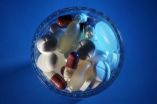(Press-News.org) Like salmon traveling upstream to spawn, sperm cells are extremely efficient at swimming against the current, according to research to be published this week.
The discovery, to be published in the journal eLife by researchers at MIT and Cambridge University, may help us to understand how some sperm travel such long distances, through difficult terrain, to reach and fertilize an egg.
Of the hundreds of millions of sperm cells that begin the journey up the oviducts, only a few hardy travelers will ever reach their destination. Not only do the cells have to swim in the right direction over distances that are around 1,000 times their own length, but they are exposed to different chemicals and currents along the way.
While we know that sperm cells can "smell" chemicals given off by the egg once they get very close to it, this does not explain how they navigate for the majority of their journey, says Jörn Dunkel, an assistant professor of mathematics at MIT, and a member of the research team.
"We wanted to know which physical mechanisms could be responsible for navigation," says Dunkel, who carried out the research alongside Vasily Kantsler of the Skolkovo Institute of Science and Technology and the University of Warwick (and currently visiting at MIT); Raymond E. Goldstein of Cambridge; and Martyn Blayney of the Bourn Hall Clinic in the U.K. "If you think of salmon, for example, they can swim against the stream, and the question was whether something similar could really be confirmed for human sperm cells."
Microchannels in lieu of oviducts
However, observing sperm cells swimming within the human body itself is no easy task. So in a bid to understand what the cells are capable of, the researchers instead built a series of artificial microchannels of different sizes and shapes, into which they inserted the sperm. They were then able to modify the flow of fluid through the tubes, to investigate how the cells responded to different current speeds.
They discovered that at certain flow speeds, the sperm cells were able to swim very efficiently upstream. "We found that if you create the right flow velocities, you can observe them swimming upstream for several minutes," Dunkel says. "The mechanism is very robust."
What's more, the researchers were also surprised to observe that the sperm were not swimming in a straight line upstream, but in a spiraling motion, along the walls of the channel. The sperm cells react to the difference in the speed of current near the walls of the chamber — where the fluid is attracted to the surface, and is therefore at its slowest — and the free-flowing center of the tube, Dunkel says.
If biologists are able to observe similar fluid-flow speeds within the oviduct, it could help confirm whether sperm cells are indeed using this mechanism to navigate through the body, he says.
Possible advances in artificial insemination
Not only would this improve our understanding of human reproduction, but it could also one day allow us to design new diagnostic tools and more efficient artificial-insemination techniques, the researchers claim. Reproduction specialists could take sperm samples and artificially recreate the conditions within the body to identify the cells that are the best swimmers, in a bid to preselect those most likely to succeed, Dunkel says.
The researchers can also experiment with different fluid viscosities within the microchannels, to determine which result in the strongest upstream swimming effect, he says. "So the idea would be to fine-tune the properties of the fluid medium that the sperm cells are contained in, before you insert it into the body, so that you know the cells can achieve optimal upstream swimming."
In the meantime, the researchers plan to begin investigating whether sperm cells can work together to reach the egg. "It is a commonly held belief that there is competition between sperm cells, with the fittest reaching the egg first," Dunkel says. "But recent studies by our team and others show that sperm practically always accumulate at the surface of a tube, and you can end up with a high local concentration of sperm cells, so there could actually be cooperation among these cells that allows them to swim faster collectively."
INFORMATION:
The research was supported by the European Research Council.
Written by Helen Knight, MIT News correspondent
Sperm cells are extremely efficient at swimming against a current
Study may explain how sperm travel long distances, through difficult terrain, to reach an egg
2014-05-27
ELSE PRESS RELEASES FROM THIS DATE:
Attack is not always the best defense
2014-05-27
Jena (Germany) It is something like the police force of our body: the immune system. It disables intruding pathogens, it dismantles injured tissue and boosts wound healing. In this form of 'self-defense' inflammatory reactions play a decisive role. But sometimes the body's defense mechanism gets out of control and cells or tissues are affected: "Then excessive reactions can occur and illnesses along with them," Prof. Dr. Oliver Werz of the Friedrich Schiller University Jena says. He gives asthma, rheumatism, arteriosclerosis and cancer as examples: "For many of these diseases ...
The secret cargo of mosquitoes
2014-05-27
The parasite Dirofilaria repens is a roundworm that primarily attacks the subcutaneous tissue of dogs and causes lumps in the skin, swelling, and itching. Dogs, cats, foxes, wolves and martens can be infected in addition to dogs. "In humans, 16 cases of human dirofilariosis have been recorded since the year 2000, but the dark figure is definitely higher", says the lead author Katja Silbermayr. Humans, however, are so-called dead end hosts; the parasite does not reproduce in humans and therefore poses no major risk.
Silbermayr is a veterinarian and performs research on ...
Seeing e-cigarette use encourages young adult tobacco users to light up
2014-05-27
VIDEO:
"Whether participants were exposed to someone smoking a combustible or an e-cigarette, the urge to smoke a combustible cigarette was just as high in either condition, " King said. "If the...
Click here for more information.
Seeing people use electronic cigarettes (e-cigarettes) increases the urge to smoke among regular combustible cigarettes users, according to a new study of young adult smokers. This elevated desire is as strong as when observing someone ...
Stanford researchers discover immune system's rules of engagement
2014-05-27
A study led by researchers at Stanford's School of Medicine reveals how T cells, the immune system's foot soldiers, respond to an enormous number of potential health threats.
X-ray studies at the Department of Energy's SLAC National Accelerator Laboratory, combined with Stanford biological studies and computational analysis, revealed remarkable similarities in the structure of binding sites, which allow a given T cell to recognize many different invaders that provoke an immune response.
The research demonstrates a faster, more reliable way to identify large numbers ...
Climate change accelerates hybridization between native and invasive species of trout
2014-05-27
BOZEMAN, Mont. – Scientists have discovered that the rapid spread of hybridization between a native species and an invasive species of trout in the wild is strongly linked to changes in climate.
In the study, stream temperature warming over the past several decades and decreases in spring flow over the same time period contributed to the spread of hybridization between native westslope cutthroat trout and introduced rainbow trout – the world's most widely introduced invasive fish species –across the Flathead River system in Montana and British Columbia, Canada.
Experts ...
New perspectives to the design of molecular cages
2014-05-27
Researchers from the University of Jyväskylä report a new method of building molecular cages. The method involves the exploitation of intermolecular steric effects to control the outcome of a self-assembly reaction.
Molecular cages are composed of organic molecules (ligands) which are bound to metal ions during a self-assembly process. Depending on the prevailing conditions, self-assembly processes urge to maximize the symmetry of the system and thus occupy every required metal binding site. The research group led by docent Manu Lahtinen (University of Jyväskylä, Department ...
Molecules do the triple twist
2014-05-27
An international research team led by Academy Professor Kari Rissanen of the University of Jyväskylä (Finland) and Professor Rainer Herges of the University of Kiel (Germany) has managed to make a triple-Möbius annulene, the most twisted fully conjugated molecule to date, as reported in Nature Chemistry (DOI:10.1038/nchem.1955, published online 25 May 2014).
An everyday analogue of a single twisted Möbius molecule is a Möbius strip. It can be made easily by twisting one end of a paper strip by 180 degrees and then joining the two ends. A triple twisted Möbius molecule ...
Insights into genetics of cleft lip
2014-05-27
Scientists at the European Molecular Biology Laboratory (EMBL) in Heidelberg, have identified how a specific stretch of DNA controls far-off genes to influence the formation of the face. The study, published today in Nature Genetics, helps understand the genetic causes of cleft lip and cleft palate, which are among the most common congenital malformations in humans.
"This genomic region ultimately controls genes which determine how to build a face and genes which produce the basic materials needed to execute this plan", says François Spitz from EMBL, who led the work. ...
Clinical trial reaffirms diet beverages play positive role in weight loss
2014-05-27
May 27, 2014 – A groundbreaking new study published today in Obesity, the journal of The Obesity Society, confirms definitively that drinking diet beverages helps people lose weight.
"This study clearly demonstrates that diet beverages can in fact help people lose weight, directly countering myths in recent years that suggest the opposite effect – weight gain," said James O. Hill, Ph.D., executive director of the University of Colorado Anschutz Health and Wellness Center and a co-author of the study. "In fact, those who drank diet beverages lost more weight and reported ...
Heavily decorated classrooms disrupt attention and learning in young children
2014-05-27
VIDEO:
Maps, number lines, shapes, artwork and other materials tend to cover elementary classroom walls. However, new research from Carnegie Mellon University shows that too much of a good thing may...
Click here for more information.
PITTSBURGH—Maps, number lines, shapes, artwork and other materials tend to cover elementary classroom walls. However, new research from Carnegie Mellon University shows that too much of a good thing may end up disrupting attention and learning in ...
LAST 30 PRESS RELEASES:
Survey reveals ethical gaps slowing AI adoption in pediatric surgery
Stimulant ADHD medications work differently than thought
AI overestimates how smart people are, according to HSE economists
HSE researchers create genome-wide map of quadruplexes
Scientists boost cell "powerhouses" to burn more calories
Automatic label checking: The missing step in making reliable medical AI
Low daily alcohol intake linked to 50% heightened mouth cancer risk in India
American Meteorological Society announces Rick Spinrad as 2026 President-Elect
Biomass-based carbon capture spotlighted in newly released global climate webinar recording
Illuminating invisible nano pollutants: advanced bioimaging tracks the full journey of emerging nanoscale contaminants in living systems
How does age affect recovery from spinal cord injury?
Novel AI tool offers prognosis for patients with head and neck cancer
Fathers’ microplastic exposure tied to their children’s metabolic problems
Research validates laboratory model for studying high-grade serous ovarian cancer
SIR 2026 delivers transformative breakthroughs in minimally invasive medicine to improve patient care
Stem Cell Reports most downloaded papers of 2025 highlight the breadth and impact of stem cell research
Oxford-led study estimates NHS spends around 3% of its primary and secondary care budget on the health impacts of heat and cold in England
A researcher’s long quest leads to a smart composite breakthrough
Urban wild bees act as “microbial sensors” of city health.
New study finds where you live affects recovery after a hip fracture
Forecasting the impact of fully automated vehicle adoption on US road traffic injuries
Alcohol-related hospitalizations from 2016 to 2022
Semaglutide and hospitalizations in patients with obesity and established cardiovascular disease
Researchers ‘listen in’ to embryo-mother interactions during implantation using a culture system replicating the womb lining
How changing your diet could help save the world
How to make AI truly scalable and reliable for real-time traffic assignment?
Beyond fragmented markets: A new framework for efficient and stable ride-pooling
Can shape priors make road perception more reliable for autonomous driving?
AI tracks nearly 100 years of aging research, revealing key trends and gaps
Innovative techniques enable Italy’s first imaging of individual trapped atoms
[Press-News.org] Sperm cells are extremely efficient at swimming against a currentStudy may explain how sperm travel long distances, through difficult terrain, to reach an egg




